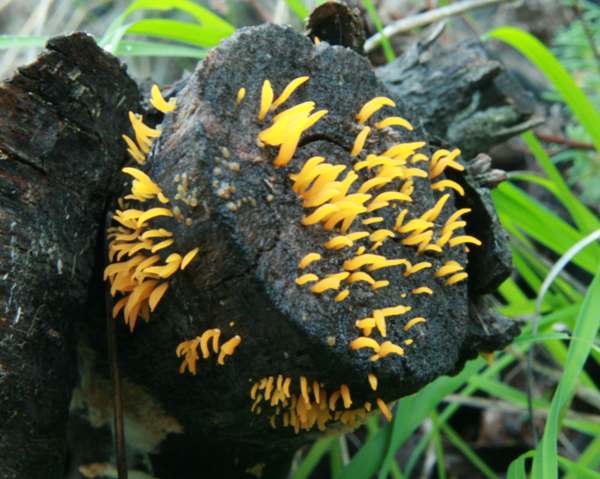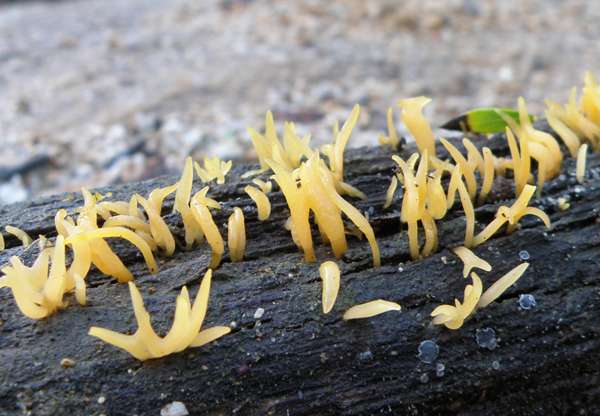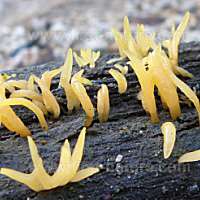Trees Birds Mammals Fish Amphibians Reptiles
Wild Algarve
Bookshop
Calocera cornea - (Batsch) Fr. Small Stagshorn
Phylum: Basidiomycota - Class: Dacrymycetes - Order: Dacrymycetales - Family: Dacrymycetaceae
Distribution - Taxonomic History - Etymology - Identification - Culinary Notes - Reference Sources

This unbranching (or only very rarely branching) jelly fungus, with tiny fruitbodies usually shorter than the thickness of a finger, can be seen on trunks and twigs of deciduous broadleaf trees.
Small Stagshorn looks rather like a club fungus; however, it is much less brittle and microscopic examination reveals that it has distinctive Y-shaped basidia, which are diagnostic characteristics of members of the order Dacrymycetales.

Distribution
Fairly common and widespread throughout Britain and Ireland, although easily overlooked because of its small size and preference for damp shady places, this gregarious wood-rotting fungus is found in most parts of mainland Europe as well as in many other regions of the world including North America.
Taxonomic history
In 1783 German mycologist August Johann Georg Karl Batsch (1761 - 1802) described this little wood-rotting fungus and gave it the binomial scientific name Clavaria cornea. Nearly half a century later, in 1827, the great Swedish mycologist Elias Magnus Fries, who had established the genus Calocera in 1821, renamed this species as Calocera cornea, which has remained its accepted scientific name up to the present time.
Synonyms of Calocera cornea include Clavaria cornea Batsch, Clavaria striata Hoffm., Tremella palmata Schumach., Corynoides cornea (Batsch) Gray, Calocera palmata (Schumach.) Fr., and Calocera striata (Hoffm.) Fr.
Etymology
Calo- as a prefix means beautiful, while the extension -cera comes from ancient Greek and means 'like wax', so that the genus name Calocera translates to 'beautiful and waxy'. The specific epithet cornea is derived from Latin, and it means 'horn'. Beautiful waxy horns... perhaps not such a bad description for these little fungi.
Identification guide

|
Fruitbody
Gelatinous and rubbery; yellow (in dry weather becoming more orange); greasy and viscid, with curved, blunt or pointed horns that are only very rarely forked at the tips; clustered in non-merging groups; 2 to 12mm tall and typically 1 to 2mm dia. |
| |
Spores
Ellipsoidal to sausage-shaped, smooth, 7-10 x 2.5-4um; hyaline; inamyloid; often becoming 1-septate when fully mature (developing a single cross wall).
Spore print
White or very pale yellow.
Basidia
Shaped like a tuning fork; 2-spored. |
Odour/taste |
Not distinctive. |
Habitat & Ecological role |
On rotting trunks and stumps of dead broadleaf trees and very occasionally on conifers. |
Season |
Fruiting through most of the year in Britain and Ireland, but
particularly prevalent during the autumn months. |
Similar species |
Calocera viscosa is much larger and has branches emanating from a short trunk.
Calocera pallidospathula is initially translucent white, and only its tips become yellowish with age.
Calocera cornea could also be confused with some of the Ramaria species of coral fungi, but
the greasysurface and rubbery texture are obvious distinguishing features. |
Culinary Notes
Although not known to cause poisoning, Small Stagshorn fungus is generally regarded as inedible because of its gelatinous texture, lack of flavour and minuscule proportions.
Reference Sources
Fascinated by Fungi, 2nd Edition, Pat O'Reilly 2016, reprinted by Coch-y-bonddu Books in 2022.
McNabb R.F.R. 1965. Taxonomic studies in the Dacrymycetaceae II. Calocera (Fries) Fries. New Zealand J. Bot. 3: 31–58.
Dictionary of the Fungi; Paul M. Kirk, Paul F. Cannon, David W. Minter and J. A. Stalpers; CABI, 2008
Taxonomic history and synonym information on these pages is drawn from many sources but in particular from the British Mycological Society's GB Checklist of Fungi.
Top of page...
Fascinated by Fungi. Back by popular demand, Pat O'Reilly's best-selling 450-page hardback book is available now. The latest second edition was republished with a sparkling new cover design in September 2022 by Coch-y-Bonddu Books. Full details and copies are available from the publisher's online bookshop...